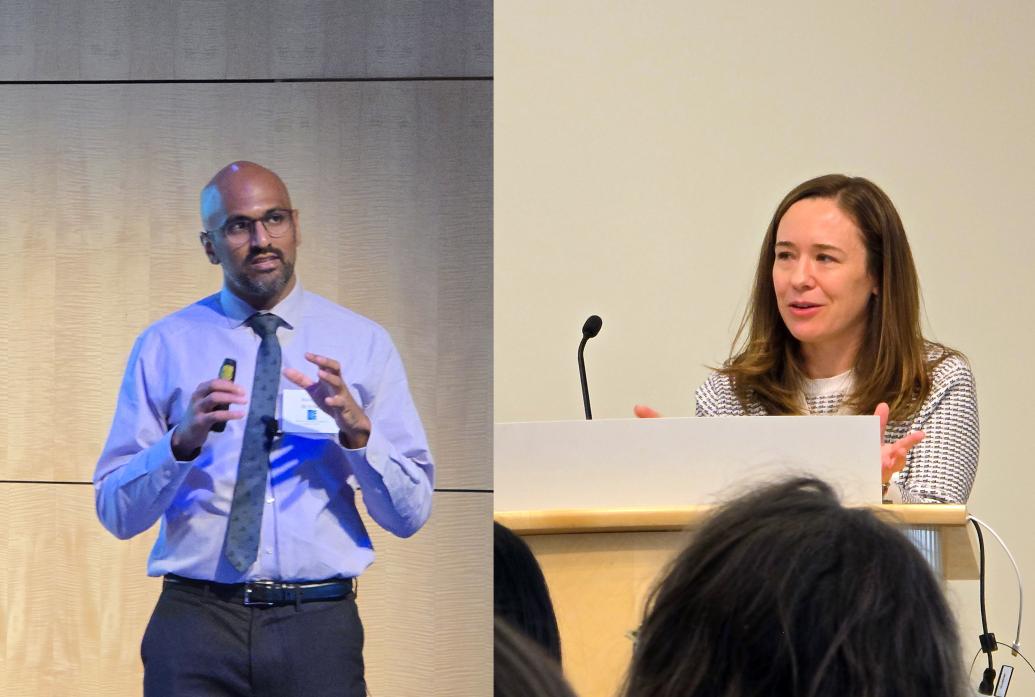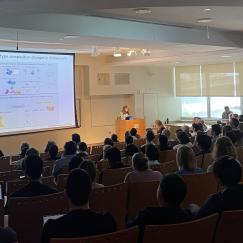Adverse experiences such as abuse and violence or poverty and deprivation have always been understood to be harmful, but the tools to understand how they may cause specific medical conditions and outcomes have only emerged recently. Technologies such as RNA or chromatin sequencing, for instance, can help scientists observe how stressors change gene expression, which can help establish mechanistic biological explanations for why people who’ve suffered adversity also experience higher risks of conditions such as stroke or Alzheimer’s disease.
Advancing scientific understanding of the physiological connections between adversity and disease can help pharmaceutical developers, physicians and public officials to develop meaningful interventions. Led by researcher Jason Buenrostro, the Broad Institute has launched a new research program, the “Biology of Adversity” project.. As leading collaborators in the effort, Picower Institute investigator Sara Prescott, assistant professor of biology, and Tsai Lab research affiliate Ravikiran Raju, a pediatrician at Boston Children’s Hospital, plan research projects in their Picower Institute labs to better elucidate how life stress leads to medical distress.
Above: Ravikiran Raju and Sara Prescott speak at a symposium previewing the Biology of Adversity project at The Broad Institute.
How can biology and neuroscience studies help people who’ve experienced adversity?
Prescott: Adversity comes in many flavors. But across different types of adversity, there is a common theme that it leads to psychological and emotional distress. If you were to ask a random person on the street, they’d probably tell you that distress is simply a feeling that exists only in the mind, rather than a biological process. But this is not true. We now appreciate that stress has predictable effects on the body, and there are severe long-term health consequences of experiencing chronic stress. Unfortunately, it’s been difficult to argue based on epidemiological data that stress itself (rather than other lifestyle factors like diet, smoking or access to health care services) is causally linked to poor health outcomes. This is confounded by the fact that we haven't had good ways to empirically measure people's levels of adversity and stress. This is part of what we want to address at the Biology of Adversity Project.
From a scientific perspective, there is still much to be understood about stress and the biological processes that lead to stress-associated diseases. And so that's hopefully where efforts like the Biology of Adversity Project are going to come in. We can use scientific practices to come up with better guidelines for ways to track levels of stress, develop diagnostics, and then, hopefully, one day this will turn into actionable interventions. It's not a random process of things going awry. There are going to be biological programs that are engaged in predictable ways. And we're trying to understand, what exactly are these neural or biological programs? How many different types of programs are there? And how do each of those programs actually work down to the cellular and molecular level?
Raju: Efforts to combat adversity and stress have largely remained in the social space to date. But what we know from a growing body of epidemiological literature is that social stressors can have profound biological impact. They cause increases in mental health disorders, physical disorders like cancer, stroke, and heart disease. Individuals who experience chronic and high levels of stress are dying sooner. I think there is an imperative to understand what these forces are doing to our biology and how they're dysregulating our physiology. Armed with that information, we can start to be more mechanistic and evidence-based in our promotion of resilience. What are the pathways that are made vulnerable when individuals are stressed? How do we rescue those deficiencies, whether it be through existing practices or novel interventions? A lot of the research we're doing here at Picower is focusing on pathways that could be targeted and leveraged using specific micronutrients or specific small molecules that help promote resilience and prevent the onset of premature illness in individuals who are stress exposed.
"Efforts to combat adversity and stress have largely remained in the social space to date. But what we know from a growing body of epidemiological literature is that social stressors can have profound biological impact." --RAVIKIRAN RAJU
What is the Biology of Adversity Project and how are each of you involved?
Prescott: My lab studies the autonomic nervous system, and we’re involved in the project’s animal studies. We think of stress as an adaptive response to prepare the body for an impending threat. When people experience stress, what happens? You engage a fight or flight response—you sweat, start to breathe harder, your heart rate goes up, your pupils dilate. This is protective in acute settings, but can become very maladaptive when these systems are activated for too long or in inappropriate settings, like when someone is having a panic attack. We predict that a lot of the long-term health consequences associated with adversity could relate to dysregulated autonomic stress responses.
And so that's where our lab’s tools come in. We have good ways in animals to measure their heart rate and breathing in response to stress. We also have a wide range of genetic tools to specifically target different neural pathways in the periphery, possibly blocking stress pathways at the source. With these tools, we can explore what role those circuits have in long-term changes in these animals with greater precision than what was possible in the past.
Raju: My involvement came through my work on the Environmental and Social Determinants of Child Mental Health Conference in 2023, which I co-hosted with Li-Huei Tsai. I think this conference made the scientific community in Boston more aware that this was something of deep interest to researchers at Picower and MIT. In the creation of the Biology of Adversity Project, the center director, Jason Buenrostro, was doing a survey of the landscape of folks who were studying stress and adversity, and who were passionate about it and connected with us because of that symposium. Since then, I've been engaged in really exciting conversations with him and a exciting group of collaborators, including Sara Prescott. And so I'm really excited that a few of our projects are being showcased as flagship projects. We are currently using animal models of early life stress to try and build preclinical models to deepen our understanding of how stress dysregulates physiology. We’re developing pipelines for trying to think about promoting resilience through targeted interventions, using those preclinical models.
I'm hoping that through this work we can move to an era where we can, from a societal perspective, understand how much our stress levels are damaging our body, be able to track that, and then find better ways to prevent the damage that's happening. — SARA PRESCOTT
What research questions do you each plan to tackle?
Prescott: Broadly, we’re interested in the body-brain connection and how this relates to stress. How do different cues from within the body—like diet, or taking a deep breath--promote or regulate stress levels? These are interesting questions about how sensory inputs from the body feed into stress circuits in the brain. We’re also interested in the other direction—understanding how stress causes changes to peripheral organs, for example, by engaging the sympathetic nervous system. It’s well understood that sympathetic neurons are responsible for making you sweat and your heart race, but do they do other things as well? For example, the field is starting to appreciate that these same neurons regulate the immune system, and can signal to stem cells to promote or suppress tissue repair. These are important pathways to understand, as they could explain some of the links between chronic stress (where sympathetic neurons are over-activated) and increased rates of diseases like cancer. It also may have therapeutic applications down the road. I’m incredibly excited for the opportunity to work with people like Ravi, and others in the project, to apply our expertise in physiology and autonomic signaling towards this immensely important problem. I'm hoping that through this work we can move to an era where we can, from a societal perspective, understand how much our stress levels are damaging our body, be able to track that, and then find better ways to prevent the damage that's happening.
Raju: We are leveraging three key mouse models of environmental perturbations in this work: environmental enrichment, social isolation and resource deprivation. In studying enrichment, we are trying to better study the factors that promote resilience to stress. In our previous work on resilience, for example, we identified a transcription factor that's specifically recruited to help ensure that neurons are resilient to the onset of Alzheimer’s pathology. So we've leveraged these enrichment models to study that mechanism and are able to then think of how that pathway might be leveraged in stress-exposed individuals. We are also using models of stress, specifically social isolation and resource deprivation. The idea here is that because mice are social mammals and rely on resources and social interactions and social networks in order to thrive, we can modulate these in a species-relevant way, and then study the pathways that are dysregulated. This will allow us to define vulnerable pathways in these preclinical models, and then assess if those same pathways are dysregulated in humans that are experiencing analagous environmental conditions. Armed with the right model, we can then determine how to reverse the physiological derangements induced by environmental stressors.





